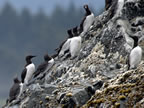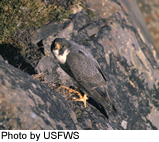 |
|
Visiting the Refuges along the Oregon Coast is rewarding year-round, because each season brings different wildlife viewing opportunities.
   
Wildlife Viewing Highlights
Download a Watchable Wildlife Map for the Oregon Coast
|
|
|
A
bird of prey, or raptor, is characterized as having excellent
eyesight, long sharp talons, and a strong rounded beak. The
two main orders of raptors are the Falconiformes and Strigiformes.
The Falconiformes, which include the hawks, falcons, eagles,
kites, and harriers are diurnal, meaning they are active during
the daytime. The Strigiformes are the owls, which are mostly
nocturnal (meaning they are active
at night), though there are some diurnal species. Vultures are
also considered birds of prey. Both the Falconiformes and the Strigiformes are
carnivorous birds, eating other small birds, rodents, reptiles, insects and small
mammals. Owls and other raptors often eat their
prey whole and then regurgitate what are called pellets consisting
of the animal's indigestible parts like bone and hair.
 Peregrine
Falcon (Falco peregrinus) - In North America,
Peregrine Falcons can be found breeding from the Arctic
Coast south to Baja. Once an endangered species, these
falcons can be found on all continents with the exception
of Antarctica. They were removed from the endangered species list in 1999 after an
estimated 1,650 peregrine pairs was cited in the US
in 1998. Peregrines use cliff ledges, and in cities they use window ledges, within close proximity
to water for nest sites in what are called aeries. Egg
laying begins as early as March but may not be completed
until late May. Clutch size is usually three to four
eggs, with an incubation period of four weeks done mainly
by the female. Young fledge at six weeks. Their diet
is made up mostly of other birds as well as rodents
and fish which they strike and capture with their sharp
talons. Peregrine Falcons are named the fastest animal
in the world, with the ability to dive at speeds of
over 220 mph. A pair of Peregrine Falcons can be seen
using Cape Meares NWR
from the viewing decks located within the Cape Meares State Scenic Viewpoint. Peregrine
Falcon (Falco peregrinus) - In North America,
Peregrine Falcons can be found breeding from the Arctic
Coast south to Baja. Once an endangered species, these
falcons can be found on all continents with the exception
of Antarctica. They were removed from the endangered species list in 1999 after an
estimated 1,650 peregrine pairs was cited in the US
in 1998. Peregrines use cliff ledges, and in cities they use window ledges, within close proximity
to water for nest sites in what are called aeries. Egg
laying begins as early as March but may not be completed
until late May. Clutch size is usually three to four
eggs, with an incubation period of four weeks done mainly
by the female. Young fledge at six weeks. Their diet
is made up mostly of other birds as well as rodents
and fish which they strike and capture with their sharp
talons. Peregrine Falcons are named the fastest animal
in the world, with the ability to dive at speeds of
over 220 mph. A pair of Peregrine Falcons can be seen
using Cape Meares NWR
from the viewing decks located within the Cape Meares State Scenic Viewpoint.
Back to top
 Bald
Eagle (Haliaeetus leucocephalus) - The Bald
Eagle is resident in North America and can be found
in almost every region of Oregon. With their distinctive
white head, yellow beak, and brown body, these eagles
can be spotted easily. The Bald Eagle's wingspan can
reach up to eight feet across. This symbol of the United States was removed from the endangered species list in 2007. Nesting occurs in forested areas
associated with bodies of water. Nest are made of sticks
and can weigh up to 2,000 pounds. Laying begins in February
but can start as late as April. Clutch size is most
often two eggs with an incubation period of thirty-five
days shared by both sexes. Fledging occurs ten to twelve
weeks after hatching. A Bald Eagle's diet is primarily
fish, but can include rodents, small mammals, and other
birds. Eagles use their large talons
to catch their prey. Bald eagles can be found at most
refuges along the coast. Bald
Eagle (Haliaeetus leucocephalus) - The Bald
Eagle is resident in North America and can be found
in almost every region of Oregon. With their distinctive
white head, yellow beak, and brown body, these eagles
can be spotted easily. The Bald Eagle's wingspan can
reach up to eight feet across. This symbol of the United States was removed from the endangered species list in 2007. Nesting occurs in forested areas
associated with bodies of water. Nest are made of sticks
and can weigh up to 2,000 pounds. Laying begins in February
but can start as late as April. Clutch size is most
often two eggs with an incubation period of thirty-five
days shared by both sexes. Fledging occurs ten to twelve
weeks after hatching. A Bald Eagle's diet is primarily
fish, but can include rodents, small mammals, and other
birds. Eagles use their large talons
to catch their prey. Bald eagles can be found at most
refuges along the coast.
Back to top
 Barn
Owl (Tyto alba) - Barn Owls are distributed
throughout
the country and on every continent except for Antarctica.
In Oregon, they are common west of the Cascades. All owls have exceptional eyesight at night but the best hearing of all birds. Their very lightweight bodies and special feathers allow them to fly through the air silently. They cannot move their eyes from side to side; instead they have the ability to turn their heads three quarters of the way around, or 270 degrees of a full circle. The Barn Owl does not make a nest; instead it finds hollow tree
cavities, barns, bridges, and cliff recesses.
Barn
Owls will breed anytime of year though most often in
the spring. Clutch size can be as few as three eggs
but can exceed ten. The incubation period is five weeks
but
the brood is not necessarily complete before the female
incubates alone. Thus hatching occurs at different times.
The young fledge at about sixty days. There can also
be more than one brood per season. Barn Owls are nocturnal
but unlike most of other owls, they forage for their
food, often flying overhead scoping out prey. Their
diet consists of mostly small mammals and rodents, with
the small occasional bird. Owls eat their prey whole
and then regurgitate what are called pellets consisting
of the animal's indigestible bone and hair. Their appearance
is unmistakable, they are also referred to as the heart-faced
owl. Though difficult to spot because of their nocturnal
instincts, their sound is easily recognizable with its
startling abrasive cry. Barn Owls are known to nest
at Nestucca Bay NWR
and can also be seen at Siletz
bay NWR. Barn
Owl (Tyto alba) - Barn Owls are distributed
throughout
the country and on every continent except for Antarctica.
In Oregon, they are common west of the Cascades. All owls have exceptional eyesight at night but the best hearing of all birds. Their very lightweight bodies and special feathers allow them to fly through the air silently. They cannot move their eyes from side to side; instead they have the ability to turn their heads three quarters of the way around, or 270 degrees of a full circle. The Barn Owl does not make a nest; instead it finds hollow tree
cavities, barns, bridges, and cliff recesses.
Barn
Owls will breed anytime of year though most often in
the spring. Clutch size can be as few as three eggs
but can exceed ten. The incubation period is five weeks
but
the brood is not necessarily complete before the female
incubates alone. Thus hatching occurs at different times.
The young fledge at about sixty days. There can also
be more than one brood per season. Barn Owls are nocturnal
but unlike most of other owls, they forage for their
food, often flying overhead scoping out prey. Their
diet consists of mostly small mammals and rodents, with
the small occasional bird. Owls eat their prey whole
and then regurgitate what are called pellets consisting
of the animal's indigestible bone and hair. Their appearance
is unmistakable, they are also referred to as the heart-faced
owl. Though difficult to spot because of their nocturnal
instincts, their sound is easily recognizable with its
startling abrasive cry. Barn Owls are known to nest
at Nestucca Bay NWR
and can also be seen at Siletz
bay NWR.
Back to top
Osprey
(Pandion haliaetus) - From Alaska to Newfoundland and
down to the Southwestern US, from the Atlantic coast  south
to Florida, the Osprey breeds in forested areas near lakes,
rivers, and the ocean. In Oregon, Osprey can be found breeding
in any forested area in close proximity to water. This bird
of prey wasn't always as abundant, along with the Bald Eagle,
it's population declined during the 1950's and 60's due to
pesticide poisoning, dropping to less than half the number
of breeding pairs. The
Osprey has since recovered and can be seen nesting in trees,
utility poles, and artificially constructed platforms. Like
other raptors, Osprey use their sharp talons to catch prey.
They hunt over shallow bodies of water and dive feet first
to pluck a fish from the surface. A clutch size of three to
four eggs is laid in early May. Incubation lasts thirty to
forty days. Once the eggs have hatched the young fledge after
fifty to sixty days. An Osprey can easily be spotted in the
air with its noticeable kink in the wing. Their wingspan can
reach five feet. Their nest is also obvious, made from large
sticks it is a large bulky formation sitting on top some kind
of platform in the middle of a clearing. south
to Florida, the Osprey breeds in forested areas near lakes,
rivers, and the ocean. In Oregon, Osprey can be found breeding
in any forested area in close proximity to water. This bird
of prey wasn't always as abundant, along with the Bald Eagle,
it's population declined during the 1950's and 60's due to
pesticide poisoning, dropping to less than half the number
of breeding pairs. The
Osprey has since recovered and can be seen nesting in trees,
utility poles, and artificially constructed platforms. Like
other raptors, Osprey use their sharp talons to catch prey.
They hunt over shallow bodies of water and dive feet first
to pluck a fish from the surface. A clutch size of three to
four eggs is laid in early May. Incubation lasts thirty to
forty days. Once the eggs have hatched the young fledge after
fifty to sixty days. An Osprey can easily be spotted in the
air with its noticeable kink in the wing. Their wingspan can
reach five feet. Their nest is also obvious, made from large
sticks it is a large bulky formation sitting on top some kind
of platform in the middle of a clearing.
All migratory birds are protected under the Migratory Bird Treaty Act, which applies to all migratory birds and their parts including eggs, nests, and feathers and forbids the taking, killing, or possessing any migratory bird, any part, nest, or eggs.
|
|
|
|

